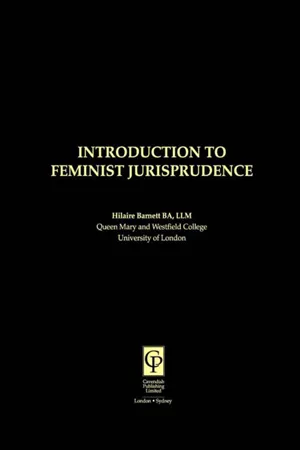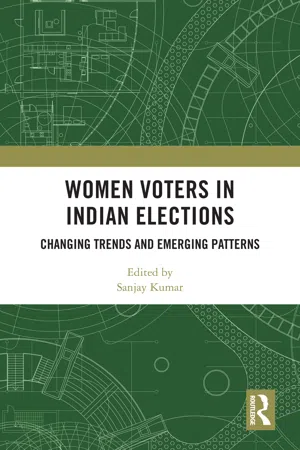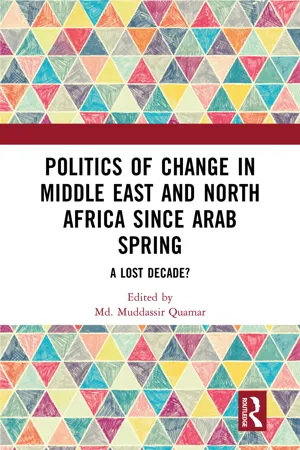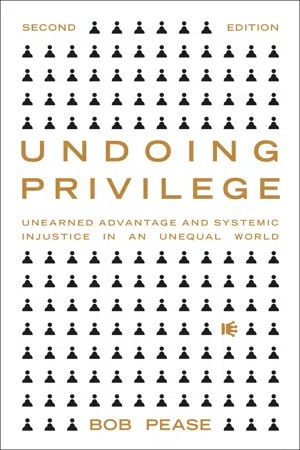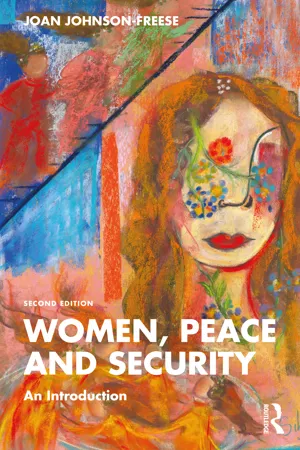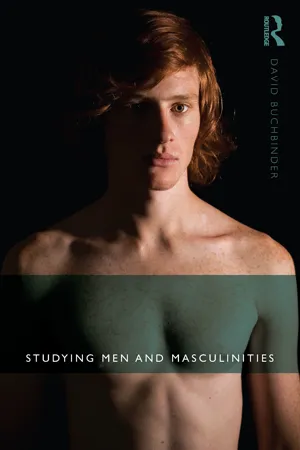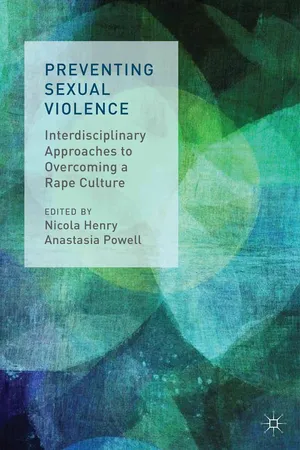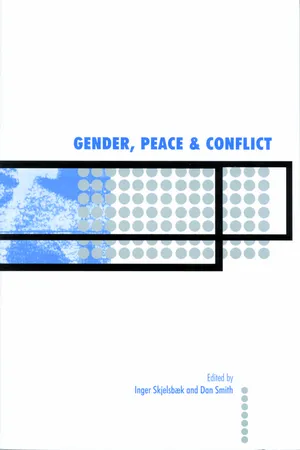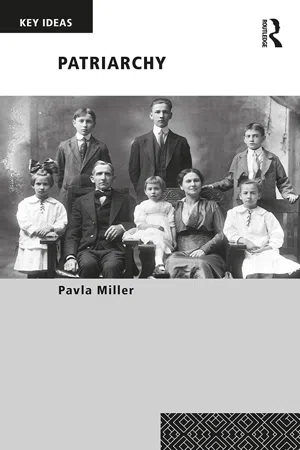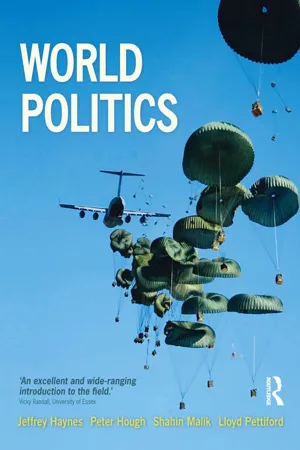Politics & International Relations
Patriarchy
Patriarchy refers to a social system where men hold primary power and dominate in roles of political leadership, moral authority, social privilege, and control of property. It is characterized by the reinforcement of traditional gender roles and the marginalization of women in decision-making processes and power structures. Patriarchy is often critiqued for perpetuating inequality and discrimination based on gender.
Written by Perlego with AI-assistance
Related key terms
11 Key excerpts on "Patriarchy"
- eBook - ePub
Men of Color in Higher Education
New Foundations for Developing Models for Success
- Ronald A. Williams, Ronald A. Williams(Authors)
- 2023(Publication Date)
- Routledge(Publisher)
The traditional and principal definition of Patriarchy is a social system whose structures and institutions, such as the family or state, are led by or dominated by men. This dominance and control include economic, social, cultural, and political institutions, such as business, government, the judiciary and the law, religious institutions, the family, and others. Patriarchy constructs the commonsensical connection between the male self, the father, the family, and the nation. It defines and naturalizes essentialized gender roles of women and men, and construes women largely in relationship, specifically in opposition, to men. Within this structure in the United States, sexist and homophobic politics and beliefs about women as well as men who enact nonnormative masculinity have flourished. Furthermore, the varying degrees of chauvinist thinking also actively devalue and disempower those attributes associated with, and those qualities culturally and socially ascribed to, women, namely the feminine. 2 These sexist patriarchal practices have kept and continue to keep men in leadership roles and decisionmaking positions as well as frequently invest in sustaining men’s economic and social options and power. Additionally, the homophobic, racial, and classed qualities of these practices in the United States simultaneously work to hierarchize and empower only certain male bodies. The attack on and deconstruction of traditional patriarchal values in regard to women was the battle cry of feminism and branches of the women’s movements of the 1960s and 1970s. The overwhelmingly White middleclass heterosexual women’s second-wave feminist movement centered Patriarchy as a system of power supporting male social control, including that of women’s bodies and lives. Patriarchy structured women’s exclusion in the workforce, underpayment, and social positioning in the home - eBook - ePub
- Hilaire Barnett(Author)
- 2013(Publication Date)
- Routledge-Cavendish(Publisher)
3 Patriarchy
DOI: 10.4324/9781843142720-3Aristotle, The Politics:1For the male is more fitted to rule than the female, unless conditions are quite contrary to nature…1 Aristotle, The Politics, Sinclair, TA (trans), 1962, London: Penguin, Bk I xii, 1259a37.Bacon, Abridgement of the Law:2…the husband hath by law the power and dominion over the wife, and may beat her, but not in a violent or cruel manner.2 1832.Luce Irigaray, ‘The bodily encounter with the mother’:33 Irigaray, L, ‘The bodily encounter with the mother’, in Sexes et Parentés, Macey, D (trans), 1993, New York: Columbia UP.Their discourses, their values, their dreams and their desires have the force of law, everywhere and in all things. Everywhere and in all things, they define women's function and social role, and the sexual identity they are, or are not, to have.While the theme of Patriarchy runs throughout this book, it is useful to focus on the concept at this early stage.4 Patriarchy and patriarchal theory, originating in ancient Greek thought, may be traced in English political theory at least to the seventeenth century which represented its high watermark. Notwithstanding its demise as a dominant political philosophy, however, Patriarchy remains evident in both the public and private spheres of life and in the laws and legal institutions regulating society.4 Patriarchy: a form of social organisation in which a male is the head of the family and descent, kinship, and title are traced through the male line; any society governed by such a system: Collins English Dictionary, 3rd edn, 1991, HarperCollins, p 1143.Explaining Patriarchy
Patriarchy represents one of the most conceptually and analytically complex theoretical constructs and lies at the heart of traditional jurisprudence and the feminist critique. Not only is the concept difficult, but there exist also differing contemporary interpretations of it. Thus liberal feminists, cultural feminists, radical feminists, Marxist-socialist feminists, black feminists, lesbian feminists all have perceptions regarding Patriarchy which while often overlapping, by no means converge into a coherent agreed definition. Thus the paradox exists: Patriarchy represents a core concept within feminist analyses of society and law, yet the content and meaning of that core concept remain contentious. - eBook - ePub
Women Voters in Indian Elections
Changing Trends and Emerging Patterns
- Sanjay Kumar, Sanjay Kumar(Authors)
- 2021(Publication Date)
- Routledge India(Publisher)
5 Internalized Patriarchy Socio-cultural and economic barriers to participation of women in politics Manjesh Rana In Theorizing Patriarchy (1990), Walby defines ‘Patriarchy’ as ‘a system of social structures and practices in which men dominate, oppress and exploit women’. The term refers to a social structure where men are considered to be superior to women, and, therefore, men’s actions and ideas dominate. This can be seen in the inequalities experienced by women in personal spaces, such as households, and in public spaces, including in the political sphere. In nearly all Indian households (as well as in households in many other countries), the eldest male is considered the ‘patriarch’ and, therefore, de facto the head of the family. Accordingly, Walby identified Patriarchy as having two distinct forms—private and public. Private Patriarchy is the household structure that can prevent women from taking part in family decision-making and from accessing public life - eBook - ePub
- Md. Muddassir Quamar, Md. Muddassir Quamar(Authors)
- 2022(Publication Date)
- Routledge(Publisher)
3. Exploring the Nexus between Democratisation, Authoritarianism and Patriarchy in Iran and Saudi Arabia Hussein Solomon and Simone BekkerIt was in the ancient Near East (specifically Mesopotamia), where Patriarchy first developed between 3100 BC and 600 BC (Lerner, 1986 , p. 8). It was, however, only in 1947 that Max Weber first used the term “Patriarchy” to describe a system of government where men used their positions as heads of households to rule societies. Radical feminists appropriated the term in the 1990s to refer to a “... system of social structures and practices in which men dominate, oppress and exploit women. The use of the term social structure is important here since it implies rejection both of biological determinism, and the notion that every individual man is in a dominant position and every woman in a subordinate position” (ibid., p. 20).There are three inter-related reasons why identifying Patriarchy in this way is important. First, reference to social structures and practices suggests that the practices of Patriarchy were constructed and can be deconstructed as the history of Western societies could attest to. Behaviour–both individual and institutional–therefore, can be unlearned (ibid., p. 6). Second, issues of gender are mediated through other variables like class, race, ethnicity, and religious affiliation. Thus, a poor rural woman from a marginalised ethnic or religious group will experience gender discrimination far more intensely than her wealthy, urban counterpart who belongs to the dominant ethnic or religious group. Third, Patriarchy viewed systemically allows one to understand the oppression of women from the workplace to the home, from issues of culture and faith to the administration of the state.Such an expanded view of Patriarchy is imperative if one considers the origins of this practice and its institutionalisation. Patriarchy is linked to issues of ownership and domination. Historically, the appropriation of women’s sexual and reproductive capacity by men was followed by the institutionalisation of private property and the emergence of class stratification. Similarly, the enslavement of women preceded the enslavement of other groups. The first states, meanwhile, owe their origins to the patriarchal family. Therefore, the earliest states had a vested interest in the subordination of women, and the earliest law codes institutionalised this subordination. By the second millennium BC, Babylon already had legislation controlling women’s sexuality (ibid., p. 89). - eBook - ePub
Undoing Privilege
Unearned Advantage and Systemic Injustice in an Unequal World
- Professor Bob Pease(Author)
- 2021(Publication Date)
- Zed Books(Publisher)
If all men are the enemy, then it is difficult to envisage the possibility of men and women working together against Patriarchy (Edley and Wetherell 1995). Notwithstanding these criticisms, Patriarchy is still useful to describe men’s systemic dominance over women across a wide range of social institutions and gendered sites. The benefit in continuing to use the term ‘Patriarchy’ is that it focuses attention on the systemic and global nature of women’s subordination and it provides a framework for identifying the privileges and advantages accruing to men as a result of men’s dominance. Many feminist writers acknowledge that Patriarchy is not monolithic and that it contains contradictions. Patriarchy is not fixed, as its form changes over time and different aspects of it have greater or lesser significance in different contexts (Walby 1990). Patriarchy is best understood as an historical structure with changing dynamics and it needs to be understood as involving the intersection of numerous factors and multiple levels of experience (Dragiewicz 2009). It may be more useful to refer to patriarchies in the plural to acknowledge the culturally specific forms that arise from different regions of the world. 5 Phallocentrism and symbolic order The origins of the term ‘phallocentrism’ are located in Lacanian psychoanalysis (Lacan 1987) which emphasises the importance of language in reproducing power relations. Derived from the Greek word phallus, the representation of the penis comes to embody patriarchal authority and hegemonic masculinity. Phallocentrism was first used by Derrida (1976) to describe the privileges associated with the male phallus - eBook - ePub
Women, Peace and Security
An Introduction
- Joan Johnson-Freese(Author)
- 2023(Publication Date)
- Routledge(Publisher)
3 PatriarchiesDOI: 10.4324/9781003413417-4Sex and world politics
As stated in the previous chapter, security is provided to individuals either through states or when that is missing, through gangs/terrorist networks or family networks, most often patriarchal networks. British primatologist Richard Wrangham and his coauthor, Dale Peterson, succinctly summed up their perspective on patriarchies in their book Demonic Males (1996):Patriarchy is worldwide and history-wide, and its origins are detectable in the social lives of chimpanzees. It serves the reproductive purposes of men who maintain the system. Patriarchy comes from biology in the sense that it emerges from men’s temperaments, out of their evolutionary derived efforts to control women and at the same time have solidarity with fellow men in competition with outsiders […] Patriarchy has its ultimate origins in male violence.1Patriarchies are those societies where men hold dominant power. More specifically, traditional patrilineal societies are those where land, titles, rights, names, and so on are inherited through the male side of the family.The patrilineal line is also known as the “spear” side of the family, as opposed to the female, or “spindle” side, and in patriarchies the two must never mix. Humanities professor Peggy McCracken references the 1997 film G. I. Jane as exemplifying the American military cultural reluctance to mix spear and spindle in a scene where female protagonist Lt. Jordan O’Neil moves into the formerly all-male barracks. “The men with whom she will share quarters express a mixture of outrage and horror when they see that Lt. O’Neil is putting what one recruit calls ‘her stuff’ into her locker: What about the tampons?” he cries to the other men. “Don’t you care about the tampons?”2 - eBook - ePub
- David Buchbinder(Author)
- 2012(Publication Date)
- Routledge(Publisher)
Patriarchy in Routledge’s New Critical Idiom series. Of course, both authors and publishers are doubtless wary of producing a text that might seem to promote and confirm Patriarchy as a positive structuring of gender, subjectivity, and, more broadly, society – or that might invite men, especially young men, to become better or more effective “patriarchs.” This would surely irritate and anger women, especially feminists, as well as the many men who support feminist ideals or harbor their own misgivings about or criticisms of Patriarchy. It would also seem historically regressive after the achievements of feminism and the various women’s movements of the past 40 years. There are, of course, books that do promote such a backward-looking intellectual, philosophical, and social position; but they rarely, if ever, feature on their front covers the word “Patriarchy.”What is “Patriarchy”?
Much of the discussion centered on gender is embedded in a strong sense of historical and cultural specificity. However, “Patriarchy” by contrast tends, especially in nonscholarly contexts, to be used as a free-floating, transhistorical, and transcultural term and point of reference. Thus, although cruder forms of feminist critique may imply that “Patriarchy” or, sometimes, “the Patriarchy” has always been around and has always oppressed women, what has been more rarely addressed are questions such as: has Patriarchy always taken the same forms, historically and socially speaking? If Patriarchy has indeed always oppressed women, has it always been in the same ways? In other words, universalizing and generalizing the concept of “Patriarchy” can be helpful only in broad-brush representations of gender politics and issues. Any closer inspection of such representations inevitably reveals flaws and gaps in the history, the logic, and the argument.Moreover, we need to distinguish between what we might call a formal Patriarchy and a symbolic or informal - eBook - ePub
Preventing Sexual Violence
Interdisciplinary Approaches to Overcoming a Rape Culture
- N. Henry, A. Powell, N. Henry, A. Powell, N. Henry, A. Powell(Authors)
- 2014(Publication Date)
- Palgrave Macmillan(Publisher)
While the various critiques of earlier use of the concept of Patriarchy have some validity, I argue here that the concept can nonetheless elucidate a multiplicity of variations in gender relations within a diverse range of patriarchal systems. It can encompass an analysis of intersections of class, race, age and sexuality. Indeed, more nuanced conceptions of Patriarchy have been developed, including the differentiation between private and public Patriarchy and the acknowledgement of multiple sites of domination and oppression within Patriarchy. Hearn (2009), for example, proposes that we talk about patriarchies in the plural and identify the importance of locating Patriarchy transnationally, which enables us to move the analysis beyond national and cultural contexts. He argues that Patriarchy takes on multiple forms within transnational patriarchies and advocates the use of intersectional analysis to interrogate the different levels of power within gendered hierarchies.It is claimed by some critics that Patriarchy only focuses on the macrostructural level. On the contrary, Ogle and Batton (2009) differentiate between two components of Patriarchy: institutionalised male domination, where male power is embedded in social structures, and male domination, whereby men exercise power over women individually and collectively. Walby (1990) refers to forms of control beyond the family as ‘public Patriarchy’ and an individual man controlling a woman in the private realm as ‘private Patriarchy’. Thus while Patriarchy operates at the structural level of government, law and bureaucracy, it also functions at the interpersonal level of interactions between individual men and women (Hunnicutt, 2009). Furthermore, it is reproduced by the practices of individual men (Ogle & Batton, 2009).Men’s practices which reproduce Patriarchy are particularly shaped by male bonding in men’s friendships. There is considerable evidence that male friends provide peer support for men’s violence as a means to control women (Dragieaicz, 2011). This includes both family and friendship networks as well as the wider community and the cultural context in which violence is practiced. While anti-violence advocates promote a proscriptive message of the unacceptability of men’s violence against women, these messages compete with imperatives among men to maintain male supremacy and male entitlement which support men’s violence against women (Dragieaicz, 2011). - eBook - ePub
- Inger Skjelsboek, Dan Smith, Inger Skjelsboek, Dan Smith(Authors)
- 2001(Publication Date)
- SAGE Publications Ltd(Publisher)
The partnership process redefines, extends and expands Patriarchy within dominant groups to encompass the public as well as the private sphere. This is because their scope of authority and influence is expanded to encompass the subordinate groups. The rule of fathers in the family, lineage, or clan is extended to non-kin groups: political parties, trade unions, colleges, schools, corporations, the civil service etc. Accordingly, it is the men of the dominant groups who become the leaders of political parties, executives of corporations, heads of trade unions, heads of the civil service and top officers in the police force.The essence of this transformation is that these non-kin associations and organizations within the public sphere of the nation come to have the same structure as that of kinship collectives in the civil society. Patriarchy is transformed: from being a feature of tribal groups and kinship collectives, it takes on new forms within non-kin associations and organizations – as ‘fathers’ within the groups leading the nationalist charge or holding great economic resources seize or consolidate their places within the nation construct. The end result is the patriarchal state, political Patriarchy, corporate Patriarchy, trade union Patriarchy etc., as men of the dominant groups seize places in these areas within the public sphere in the nation.The movement away from the rule of fathers in blood-bonded collectives to that of men in political parties, corporations, trade unions, colleges, schools, and other non-kin organizations transforms Patriarchy from being the rule of fathers to being the rule of men. In the absence of filial relationships, the rule of fathers becomes the rule of men. Dahlerup (1987) has noted the emergence of the patriarchal state, observing that its defining feature is that it functions in the interest of men. My interpretation diverges slightly from this: I would say that the patriarchal state is commandeered by the men and women of the groups who control its mechanisms, to serve their interests and prerogatives. - eBook - ePub
- Pavla Miller(Author)
- 2017(Publication Date)
- Routledge(Publisher)
In a recent interview (Cohn and Enloe 2003), Enloe described how she was mortified when, as a newly self-conscious feminist, she realised her book’s manuscript contained only two mentions of women, and terrified when, in 1980, a senior colleague told feminist conference participants ‘We have to talk about Patriarchy’. Today, she noted, she could not imagine trying to think seriously about the constructions of power and the systems by which power is both perpetuated and implemented without talking about Patriarchy. Remembering how scary the term sounded to her, she tries to provide a lot of examples in her detailed work on topics such as the British House of Commons, textile companies, the Israeli military, Chilean political parties, and Bosnia’s and Afghanistan’s new governments. Patriarchy, she adds, ‘is not a sledge hammer being swung around a raving feminist head. It is a tool; it sheds light at the same time as it reveals patterns of causality’. She keeps using the concept because ‘it reminds us that we’re investigating power’. She then defines Patriarchy not as a pre-existing structure making people do things, but as a network of unequal social relations that delimits people’s actions but is full of glitches and contradictions and has to be constantly patched up:It is not men on top that makes something patriarchal. It’s men who are recognized and claim a certain form of masculinity, for the sake of being more valued, more ‘serious’, and ‘the protectors of/and controllers of those people who are less ‘masculine’ that makes any organization, any community, any society patriarchal. It’s never automatic; it’s rarely self-perpetuating. It takes daily tending. It takes decisions – even if those are masked as ‘tradition’. It relies on many women finding patriarchal relationships comfortable, sometimes rewarding.(Cohn and Enloe 2003: 1192)Not least because of the unpredictability and variability of social relations, Enloe is especially influenced by feminist-informed, historically minded ethnography, and tries to assemble accounts of what would later be called ‘total social division of labour’.In her work on armies and wars, for example, Enloe (1983) shows how militarism and the military affect everyone. Women are involved as military wives, soldiers’ mothers and sisters, prostitutes, entertainers, cleaners, workers in munitions factories, civilian casualties, supporters of military campaigns or anti-war activists, and more recently as soldiers themselves. Patriarchy is there as a background force making sense of complex developments, but is full of contradictions, and always an achievement in the making. ‘What becomes surprisingly clear, as one examines these military processes’, Enloe (1983: 213) notes, ‘is that the military is often very confused’. True to her word, Enloe uses the concept sparingly; around once in nineteen pages in both Does Khaki Become You and Bananas, Beaches and Bases - eBook - ePub
World Politics
International Relations and Globalisation in the 21st Century
- Jeffrey Haynes, Peter Hough, Shahin Malik, Lloyd Pettiford(Authors)
- 2013(Publication Date)
- Routledge(Publisher)
It certainly seems to simplify both the problem and the application of a solution. Historically the state has performed as a patriarchal site of power, but the state is not inherently patriarchal. That is to say, feminist organisations and women's groups have successfully lobbied to change government policies and interventions, often in ways that bring positive benefits to women. Critical feminists view the state both as a set of power relations and political processes in which Patriarchy is both constructed and contested. From this perspective, feminists can work through the state to try to achieve positive changes for women. Some of the most interesting feminist work in IR is being done in the general area of gender, sexuality and sexual identities (see Chapter 19). This is part of a much broader critical interest in sexualities and identities in contemporary International Relations, which is not exclusively feminist. Feminists have drawn upon some of this work in order to develop a critique of gender bias and the profoundly masculinised and feminised imagery which is employed in orthodox (Realist) IR discourse. Gender is also a central factor in understanding world orders, old and new. Given the emphasis on gender as a specific form of inequality which is supported and perpetuated by social institutions/practices and ideologies, critical feminism has much to say about world order and the nature and purpose of international institutions. What does the world order look like when viewed from a feminist perspective? How do the policies of international organisations and institutions like the UN, the World Bank and the International Monetary Fund affect gender relations in countries across the world? There is a growing critical feminist literature on gender relations, which is integrated into and informed by an analysis of the changing ‘world order’
Index pages curate the most relevant extracts from our library of academic textbooks. They’ve been created using an in-house natural language model (NLM), each adding context and meaning to key research topics.

